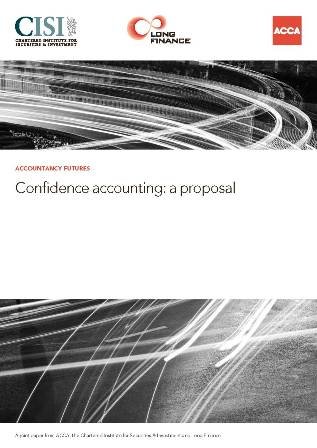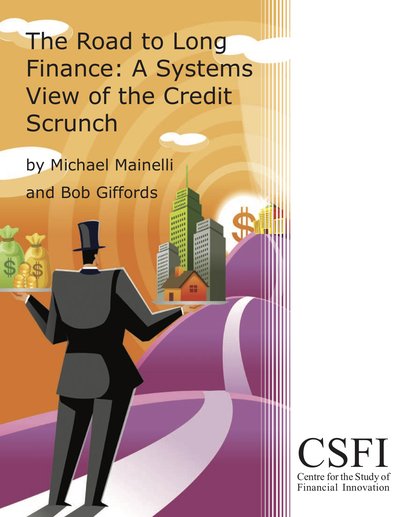Confidence Accounting
A Bold Proposal from Long Finance, ACCA & CISI
Confidence Accounting is a proposal to use distributions, rather than discrete values, where appropriate in auditing and accounting. In a world of Confidence Accounting, the end results of audits would be presentations of distributions for major entries in the profit & loss, balance sheet and cashflow statements. The proposed benefits of Confidence Accounting include a fairer representation of financial results, reduced footnotes, more measurable audit quality and a mitigation of mark-to-market perturbations. The landmark, free-to-download report was published on 5 July 2012 (press release):
Confidence Accounting: A Proposal
by Ian Harris, Michael Mainelli and Jan-Peter Onstwedder of Z/Yen Group
published by ACCA, Long Finance and CISI.
July 2012
63 pages
Andy Haldane, Executive Director for Financial Stability at the Bank of England welcomes the proposal and writes in the foreword, “My hope is that this proposal moves our thinking a step closer towards a set of accounting standards for major entities that put systemic stability centre stage. In the light of the crisis, anything less than a radical re-think would be negligent.”
Responses to the July 2012 report are available online. The publication included a invitation to readers to comment on the content of the proposal. A questionnaire was circulated during events and was also available online. Read the Confidence Accounting Consultation Responses for more information.
For a quick introduction to Confidence Accounting, particularly its application to banking, in 2011 the CISI published “Accounting for Confidence” which provides a short overview. Confidence Accounting was introduced for the non-professional in “The Price of Fish: A New Approach to Wicked Economics and Better Decisions”, winner of the 2012 Independent Publisher Book Awards Finance, Investment & Economics Gold Prize.
Reactions
Over the course of the following year, each of the three publishing organisations held a number of events highlighting the role that Confidence Accounting could play in reforming auditing. Confidence Accounting gained significant traction with the Institute of Chartered Accountants of Scotland (ICAS) when their President, Sir David Tweedie, former Chairman of the International Accounting Standards Board, hosted their December 2012 debate on audit reform, praising the initiative, and later followed up this support at a March 2013 CISI-ICAS joint event “Financial Reporting Unplugged”. Articles have appeared in CIMA, ICAEW, and ACCA magazines. Letters of support arrived from several US academics and the work was referenced in academic research by Bank of England employees.
Also in 2013 ACCA published the consultation responses, consisting of about half email submissions and half questionnaires submitted by attendees at events – around 100 people. Virtually everyone agreed that audit and accountancy need to improve. Respondents seemed to divide into three camps – supporters (about half), change-is-too-hard (about 40%), and anti this specific approach (about 10%). There was a desire to explore a simple ‘how to’ primer, a desire to apply the approach particularly to tax, pensions, natural resources & insurance, and a desire to coordinate Confidence Accounting approaches with more real-time information provision.
Following from the consultation the authors believe, first, that the use of distributions would probably best start with the balance sheet alone, leaving the other financial statements to change later. Second, while regulatory, institute, legislation and audit standards might be useful change agents, Confidence Accounting can begin immediately in the dialogues between audit committees and their auditors. Looking ahead, the challenge is to find ways to keep the discussion in the forefront of regulatory discussions while also finding simple steps, rather than a large leap, towards implementation.
We’d like to keep the momentum by showing people the discussion is developing, that the institutes are encouraging discussion about the fundamentals of accounting & audit, and that technical accountants should pile in. We had a large conference in March 2014 at ACCA, with ICAS, CFA, Governance for Owners, etc. there, on “accounting for uncertainty”. About 100 people turned up. The background was to take a hard look at the idea over the day and decide if it held up and if our suggestion of beginning with audit committees made sense. As the organiser, Paul Moxey, summarised:
Accounting for Uncertainty
The final session discussed whether and how Accounting for Uncertainty or Confidence Accounting could help audit committees to fulfil their obligations to consider whether financial statements are ‘fair, balanced and understandable’. 94% of those answering agreed or strongly agreed that there is a need to better represent uncertainty in financial statements. 97% seemed to think that the diagrams used in the discussion paper would be useful.
FT Coverage and our shortest explanation:
Banking On Confidence: Rethinking Audits Of Financial Institutions, Michael Mainelli, Securities & Investment Review, Securities & Investment Institute (September 2011), pages 22-23.
Confidence Accounting is also strongly related to Financial Statements Assurance:
Put Your Money Where Your Audit Is: Financial Statement Insurance In The UK?, Michael Mainelli and Joshua Ronen, Journal of Risk Finance, The Michael Mainelli Column, Volume 7, Number 4, Emerald Group Publishing Limited (2006), pages 446-450.
Accounting: Progress May Lie In Insurance (Put Your Money Where Your Audit Is: Financial Statements Insurance In The UK?), Michael Mainelli and Joshua Ronen, Financial World, Institute of Financial Services and Centre for the Study of Financial Innovation (2006), pages 38-39.
Long Finance has a number of other research areas and suggestions – https://www.longfinance.net/research/our-research/. This mid-2009 publication has been rather prophetic:
The Road To Long Finance: A Systems View Of The Credit Scrunch, Michael Mainelli and Bob Giffords, Centre for the Study of Financial Innovation (2009), ISBN: 978-0-9561904-4-4, 62 pages.
Read More
- Edward D. Weinberger (2015): Financial Statement Items as Interlinked Stochastic Processes. IMA Research Incubator, Grant Final Report.
- John Davies (2014): Courting Confidence. Accountancy Futures, ACCA: page 40.
- Michael Mainelli (2014): What Has Accounting Got To Do With The Price Of Fish? Economia, Institute of Chartered Accountants of England and Wales.
- Michael Mainelli (2014): Comment: Accountants Could Benefit From Thinking Like Engineers. Engineering & Technology Magazine.
- Michael Mainelli (2014): Why Spurious Financial Precision May Be Killing Our Markets – And Our Fish. City AM.
- David Rowe (2014): Prudent Valuation Versus Confidence Accounting. Risk Magazine.
- ACCA & Long Finance (2013): Confidence Accounting Consultation Responses.
- Investment Management Review (2013): Revolutionary Accounting Method Proposed.
- Michael Mainelli & Jan-Peter Onstwedder (2012): Buried Treasure Naturally Confident – Accounting For Resources. The CA, Institute of Chartered Accountants of Scotland.
- Michael Mainelli (29 July 2012): The Battle For Accountancy Has Begun. Financial Times, FTfm, Pearson PLC: page 6.
- Eric Tracey (2012): Confident Accounting. Financial Director.
- Michael Mainelli (2011): Accounting For Confidence. Securities & Investment Review: pages 22-23.
- Michael Mainelli (October 2011): Banking On Confidence: Rethinking Audits Of Financial Institutions. Corporate Governance and Sustainability Challenges.
- Michael Mainelli (2009): Confidence Accounting: Putting Essential Uncertainty Back Into Auditing And Accounting. EURO CFO Ltd, Aerial.
- Michael Mainelli (June 2009). Confidence Accounting: Putting Essential Uncertainty Back Into Accountancy. Journal of Risk Finance, Vol.10 (No.3). Emerald Group Publishing Limited.
- 2006 Symposium: Reforming Auditing - Incremental Change Or Radical Action?
Citations
- David M. Bholat. (July 2013): "The Future of Central Bank Data". Journal of Banking Regulation.

